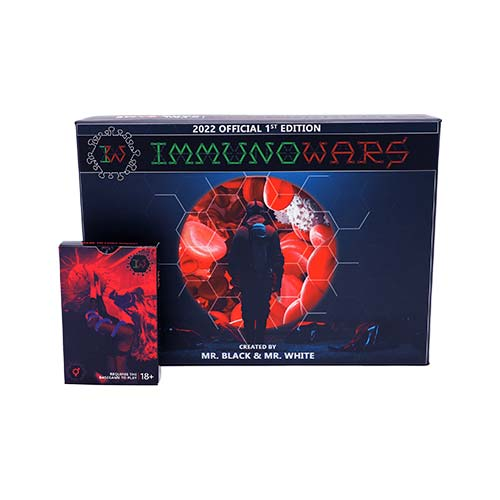Authors: In collaboration with Dr. Anniek van der Waart, written by Liliana Sánchez Rocha, MSc.
Read time: 8 minutes
The war against cancer occurs every day in each one of us. As our cells divide and DNA replicates, errors can occur. If they go unnoticed, these mistakes accumulate and might result in uncontrolled growth and rejection of the body’s rules, giving rise to cancer. Yet, we don’t develop cancer every day. So, what happens? It turns out that the body has weapons to uncover and put an end to the cell rebellion. But which immune cell oversees this task? Although not the only one in this fight, cytotoxic T cells are armed to eliminate any cell exhibiting suspicious behavior. For this immune role, cytotoxic T cells, together with other immune arsenal like Helper T cells, have been chosen as key players in the innovative cancer treatment called CAR-T. For this edition, ImmunoWars spoke with Dr. Anniek van der Waart, an experienced immunologist and lecturer at Radboud University. Anniek’s fascination for T cells has taken her to immerse herself in the immune tactics against cancer. We’ll be introduced to the cytotoxic T cell’s world and their role in CAR-T cell therapy through Anniek’s eyes.

What are cytotoxic T cells and what is their role in the immune system?
Cytotoxic T cells (CTL) are members of a larger army known as “T cells.” What are these T cells? “A T cell is an immune cell that defends our body against things that should not be present. They come in different flavors like Helper T cells (CD4+), and Cytotoxic T cells (CTL) also known by its membrane protein CD8+ T cells” Anniek answered. One characteristic of CTL is its ability to interact and communicate with almost all cells in the body through their MHC I molecule (1). Why is it important? MHC I displays samples from the inner cell activity, if there is any abnormality going on, MHC I will exhibit it. Additionally it works as the cell self-identity card and resident permit (2).
Once activated, CTL will detect its target even if it’s hidden inside any cell, therefore “CD8+ T cells are really good in killing virus-infected cells or cancer cells in our body” Anniek adds. However, killing our own cells is a job that needs to be strictly regulated by other immune cells: “T cells can be seen as soldiers that need to be instructed by the generals. In this case, dendritic cells (DC) or other antigen presenting cells (APC).”
How can cytotoxic T cells (CD8+) detect cancer?
It all starts with DCs, which are equipped to detect suspicious molecules, foreign or from the corrupted metabolism of a cancerous cell (3). Triggered by this threat, “DC they travel to the nearest lymph nodes, a type of T-cell home station where they activate CTL.” To achieve this, the communication needs to be established through the MHC I on the DC and the T cell receptor (TCR) on the CTL side. “TCR recognizes only one specific small peptide structure, and it’s unique to one T-cell.” “We have a massive diversity of T cells in our body, making sure that we can recognize everything that doesn’t belong or can damage the body” Anniek explains.
When the specific CTL for the suspicious molecule is found, DCs fire off cytokines commanding CD8+ T cells: Survive, multiply, build an army, and kill! Along with a precise map of where the danger was discovered (2). “It’s really fascinating that these signals and chemokines show the specific location so that T-cells know where to go back. However, some parts of this mechanism are still unknown.” Just after activation, CTLs are licensed to kill. Did you know your daily choices can shape how these cells fight cancer?
How do CD8+ T cells kill?
Activated CD8+ T cells can directly scan the MHC I, when the specific peptide is found and DC’s give the proper instruction (costimulation), the mission culminates with a directed and controlled deployment of cytotoxic proteins. Perforin goes first to punch holes in the target-cell membrane. The attack is followed by a lethal hit of granzyme and granulysin inducing an immediate, controlled, and “silent” cell death. CD8+ T cells can use an alternative mechanism, they can activate the suicidal switch (FAS) in the suspicious cell (2).
What is the difference between Cytotoxic T cells and natural killer (NK) cells?
CTL are not the only deliberated assassins; NK cells are also born to kill. What’s the difference? “NK cells are part of the innate immune system, which doesn't need instructions from another cell” Anniek explains. Why would that be? While CTLs need contact with the MHC I to uncover dubious inner activity, NK cells go after cells that have lost it and thus lost their identity. In this way, NK eliminates cells that don’t belong to the body or those hiding MHC I. Why a cell would hide MHC I? This is tactic from the cell invaders or cancerous cells to evade CTL (4). “NKs are the first offence for a short period, and CTLs develop memory and become a long-term prevention.” And yet, despite these and other immune tactics, cancer exists…

How our daily choices can interfere with our immune system protection?
“The toxins from smoking and alcohol actually affect our immune system” Anniek describes. These toxins can weaken the “cancer detection” by CD8+ and NK cells, and impair antiviral defenses (5). Alcohol can also disrupt how immune cells grow and function, pushing them toward harmful inflammation (6). However, aging, stress, chronic infection, and poor sleep are some natural and common factors that weaken the immune forces (7, 8). Scientists like Anniek seek to revitalize and give back CD8+ T cells their power to fight cancer.
What is the role of CD8+ T cells in CAR-T cell therapy?
As science finds out more about cancer survival tactics, more techniques are being developed to restore the immune power. Anniek explains: “CAR-T therapy started to be developed in the 80´s for lymphoma patients.” How does it work? “T cells are taken from the patient, then they're genetically modified in the lab. In the lab, DNA is added to help them create new receptors besides their natural TCR. This new receptor (chimeric antigen receptor: CAR), gives CTL a better way to recognize tumor cells.” This new tailor-made receptor is engineered to recognize a molecule associated to cancer cells like CD19 on B cells. Once the T cells have been empowered, activated, and multiplied, this new army is reintroduced into the patient. “This therapy has allowed 40 to 50% of patients to survive long term.”
What is the future of CAR-T cell therapy?
“There is a lot of studies going on to make it possible to use CAR-T cell therapy in other diseases, but we are not there yet. Currently research strives to make T cells able to recognize two different elements of the tumor cells, but also make sure that these CAR-T cells stay longer in the patient. Then patients would not only be treated of cancer, but it could also prevent possible recurrence of the disease in five or ten years” Anniek emphasize.
What are some of the biggest challenges of CAR-T therapy?
According to Dr. van der Waart, “The most challenging part is making a really successful therapy even better and still keeping it affordable in healthcare. Paradoxically, all the things we are doing to make it better are also making it more expensive. So, another part of research is focusing on making these therapies financially accessible for the public, and therefore treat more patients.”
What has impressed you the most about T cells?
“It keeps intriguing me how T cells can give long-term protection against rigorous disease. A recent study in mice showed that T cells can live longer than the mice itself (9). So, it's really the strength of the T cell there, they have great potential as long as you give them the right instructions, they're really, really powerful” Dr. van der Waart shares.
If you could add a power to the Cytotoxic T cell card in the ImmunoWars game, what would it be?
“I think their long-term protection and of course their killer potential” Dr. van der Waart finalizes. CD8 T cells is undoubtedly one of the most powerful tools in cancer immunotherapy.
More on Dr. Anniek van der Waart research

Curious on ImmunoWars game and how to use CD8+ cytotoxic power?
References:
1. Wu X, Li T, Jiang R, Yang X, Guo H, Yang R. Targeting MHC-I molecules for cancer: function, mechanism, and therapeutic prospects. Molecular Cancer. 2023;22(1):194.
2. Raskov H, Orhan A, Christensen JP, Gögenur I. Cytotoxic CD8+ T cells in cancer and cancer immunotherapy. British Journal of Cancer. 2021;124(2):359-67.
3. Qian W, Ye J, Xia S. DNA sensing of dendritic cells in cancer immunotherapy. Frontiers in Molecular Biosciences. 2024;11.
4. Mace EM. Human natural killer cells: Form, function, and development. J Allergy Clin Immunol. 2023;151(2):371-85.
5. Molina JC, Guerrero-Morán JD, González-Espinosa C. Alcohol: Immunomodulatory Effects and Cancer. Rev Invest Clin. 2023;75(3):129-42.
6. Pasala S, Barr T, Messaoudi I. Impact of Alcohol Abuse on the Adaptive Immune System. Alcohol Res. 2015;37(2):185-97.
7. Wherry EJ, Kurachi M. Molecular and cellular insights into T cell exhaustion. Nat Rev Immunol. 2015;15(8):486-99.
8. Lian J, Yue Y, Yu W, Zhang Y. Immunosenescence: a key player in cancer development. Journal of Hematology & Oncology. 2020;13(1):151.
9. Bernard NJ. T cells last longer than mice. Nature Immunology. 2023;24(3):377-.


